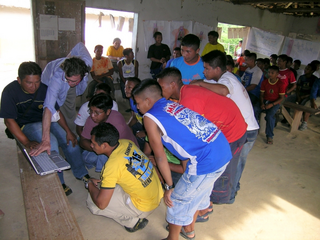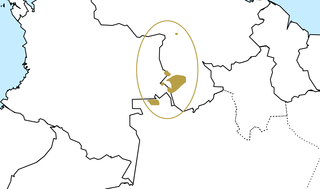
The glottal stop or glottal plosive is a type of consonantal sound used in many spoken languages, produced by obstructing airflow in the vocal tract or, more precisely, the glottis. The symbol in the International Phonetic Alphabet that represents this sound is ⟨ʔ⟩.

Baniwa are indigenous South Americans, who speak the Baniwa language belonging to the Maipurean (Arawak) language family. They live in the Amazon Region, in the border area of Brazil, Colombia and Venezuela and along the Rio Negro and its tributaries.

Arawakan, also known as Maipurean, is a language family that developed among ancient indigenous peoples in South America. Branches migrated to Central America and the Greater Antilles and Lesser Antilles in the Caribbean and the Atlantic, including what is now the Bahamas. Almost all present-day South American countries are known to have been home to speakers of Arawakan languages, the exceptions being Ecuador, Uruguay, and Chile. Maipurean may be related to other language families in a hypothetical Macro-Arawakan stock.
Swedish or svensk(a) may refer to:
The voiceless palatal nasal is a type of consonantal sound, used in some spoken languages. The symbols in the International Phonetic Alphabet that represent this sound are ⟨ɲ̊⟩ and ⟨ɲ̥⟩, which are combinations of the letter for the voiced palatal nasal and a diacritic indicating voicelessness. The equivalent X-SAMPA symbol is J_0.
The Upper Amazon Maipurean languages, a.k.a. North Amazonian or Inland Northern Maipuran, are Arawakan languages of the northern Amazon in Colombia, Venezuela, Peru, and Brazil.

Karu, one of several languages called Baniwa (Baniva), or in older sources Itayaine (Iyaine), is an Arawakan language spoken in Guainía, Colombia, Venezuela, and Amazonas, Brazil. It forms a subgroup with the Tariana, Piapoco, Resígaro and Guarequena languages. There are 10,000 speakers.
Warekena (Guarequena), or more precisely Warekena of Xié, is an Arawakan language of Brazil and of Maroa Municipality in Venezuela, spoken near the Guainia River. It is one of several languages which go by the generic name Baré and Baniwa/Baniva – in this case, distinguished as Baniva de Maroa or Baniva de Guainía.
Barawana (Baré) is an Arawakan language of Venezuela and Brazil, where it is nearly extinct. It was spoken by the Baré people. Aikhenvald (1999) reports "just a few old speakers left" of Baré proper, and that the Guinau variety was extinct. Kaufman (1994) considers Baré proper, Guinau, and Marawá to be distinct languages; Aikhenvald, dialects of a single language.
Abane (Avane), one of several languages called Baniwa, also known as Baniva Yavitero, was an Arawakan language of Venezuela. It is believed to have become extinct by the late 20th century, and is only attested in a short word-list from the late 18th century.
Tapuya is a Tupian term meaning ‘enemy’ or ‘foreigner’ that is used to refer to various unrelated non-Tupian ethnic groups. It can refer to:
The voiceless alveolar lateral flap is a type of consonantal sound, used in some spoken languages. The symbol in the International Phonetic Alphabet that represents this sound is ⟨ɺ̥⟩, a fusion of a rotated lowercase letter ⟨r⟩ with a letter ⟨l⟩ and a voiceless diacritic.
This page is based on this
Wikipedia article Text is available under the
CC BY-SA 4.0 license; additional terms may apply.
Images, videos and audio are available under their respective licenses.



